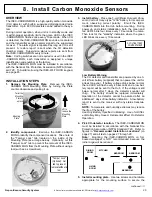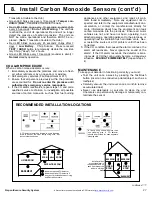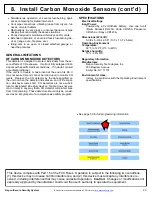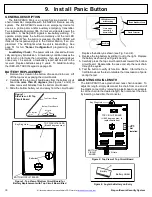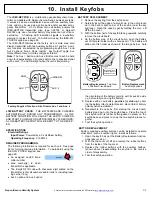
16
All technical manuals are available in PDF format at
tech.napcosecurity.com
Napco iSecure Security System
The
ISEC
-
GLASSBREAK
is an advanced wireless acoustic
glass
-
break detector for use with the iSecure
Go
-
Anywhere
Smart Hub
and receivers. Each transmitter has a unique RF
ID code (printed on the sensor module and on the rear case)
that distinguishes itself to the receiver. Refer to Go
-
Anywhere
Smart Hub instructions for entering this code and its check-
sum digit into the Hub. Be sure to enter all numbers and/or
letters, including leading zeros, if any. To AutoEnroll using
the ISEC
-
WL
-
TOUCH keypad, see page 65.
The detector is powered by two type DL123A or CR123A 3
-
volt lithium batteries, which are factory installed. To energize
the unit, simply install the supplied Power
-
Up Jumper across
pins JP1 near the positive terminals of the batteries.
SPECIFICATIONS
Microphone: Electret, omnidirectional
Temperature Range: 32°F to 120°F (0°C to + 50°C)
Range of Coverage (radius distance from sensor):
Plate Glass, 25' (7.6m)
Tempered, Wired, or Laminated Glass, 20' (6m)
Note:
(1) Use 20' (6m) radius if unsure of glass type. (2) If
not using a Sentrol 5709
-
C Tester to verify range, reduce
range to 15' (4.5m) for windows with blinds or unlined
drapes. (3) Reduce coverage 50% for armor
-
coated
glass.
Glass Thickness:
Plate Glass, 3/32" to 1/4" (2.4 to 6.4mm)
Tempered Glass, 1/8" to 1/4" (3.2 to 6.4mm)
Wired Glass, 1/4" (6.4mm)
Laminated Glass, 1/8" to 1/4" (3.2 to 6.4mm)
Dimensions (HxWxD): 3.13 x 4.24 x 1.7" (8.0 x 10.8 x 4.3cm)
Shipping Weight: 7.5oz (213gm)
FEATURES
•
Superior immunity to false alarms
•
Excellent detection, even through blinds and light drapes
•
25' radius
•
Automatic test for easy installation
•
"Hand
-
clap" test for sensor verification
•
Includes lithium batteries
MOUNTING
Note:
The ISEC
-
GLASSBREAK may be mounted in any po-
sition with no degradation in performance. However, for refer-
ence purposes in this text, the unit will be considered oriented
with the antenna at the right, as shown above.
The detector mounts with two #6 screws (supplied). The rear
case may be used as a template to mark mounting holes on
the wall.
The sensor must be in direct line of sight of all windows being
protected. Reliable detection cannot be expected around cor-
ners, in other rooms, etc. For optimum false
-
alarm immunity,
avoid installing the unit
•
in rooms with lined, insulating, or sound
-
deadening
drapes;
•
in rooms with closed wooden window shutters inside;
•
in rooms smaller than 10' x 10' (3m x 3m), and in rooms
with multiple sounds, such as kitchens, glass booths,
noisy areas, garages, etc.
•
within 4' (1.2m) of noise sources such as televisions,
speakers, sinks, doors, etc.
•
on ceilings higher than 15' (4.5m), if mounting on ceiling;
•
on 24
-
hour loop applications (perimeter loop okay);
•
where white noise (such as air compressor noise) is pre-
sent (may cause false alarms by saturating glass
-
break
frequency spectrum).
Wall Mounting
Since the sound of breaking glass travels outward from the
source, the best location for the ISEC
-
GLASSBREAK detector
is on the wall opposite the windows being protected
(assuming, of course, that the wall is within the sensor's
range). Detection is reduced with same
-
wall mounting since
such detection is partially dependent upon sound reflected off
the opposite wall.
Ceiling Mounting
Similarly, a ceiling
-
mounted sensor will detect better if mount-
ed 6' to 10'
(2
—
3
m) away from the glass, rather than directly
above it. Mount the detector on any type of ceiling in direct
line of sight of the windows being protected, at least 1' (0.3m)
and preferably 3' (1m) from the glass. See Fig. 3.
Installation Notes
1.
The unit is designed to detect the shattering of framed
glass mounted in an outside wall. Testing the sensor with
unframed glass, broken bottles, etc. may not trip the sen-
sor. The unit typically does not trip to glass
-
break tests in
the middle of a room, as such breaks are false alarms.
2.
False alarms are most likely to occur when installed on a
24
-
hour loop in glass airlocks and glass vestibule areas,
4. Install Glass
-
Break Sensors
COVERAGE AREA ALL GLASS
ADDITIONAL COVERAGE AREA
FOR PLATE GLASS
UNPROTECTED AREA
Fig. 2. Typical coverage pattern for wall
-
mounted units.
Fig. 1. ISEC
-
GLASSBREAK detector, cover removed.
POWER
-
UP
JUMPER J1
MOUNTING
HOLE
ANTENNA
SENSOR
(MICROPHONE)
LED
TAMPER
SWITCH
MOUNTING
HOLE
BATTERIES
























